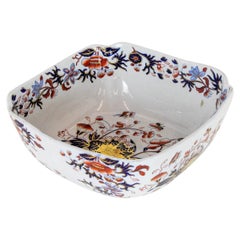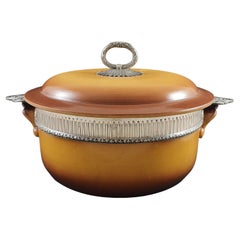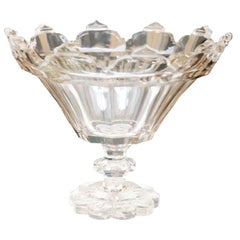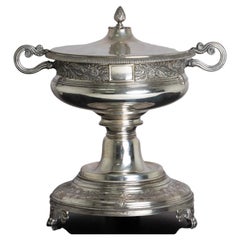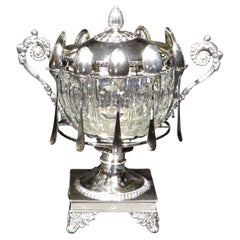1830s Serving Bowls
5
to
1
3
2
5
5
5
1
78
314
1,392
404
316
705
223
60
20
40
54
55
109
148
88
37
19
2
2
2
2
1
4
2
2
1
1
1
Period: 1830s
Antique French Silver and Cut Glass Caviar / Serving Dish
Located in Jesmond, Newcastle Upon Tyne
A magnificent, fine and impressive antique French silver and cut glass serving/caviar dish; an addition to our ornamental silverware collection
This magnificent antique French silver and cut glass caviar/serving dish has circular shaped form onto a pedestal and square base.
This antique silver dish is fitted with an exceptional cut glass body.
The upper and lower portions of the dish are encompassed with impressive French silver mounts embellished with chased lobed stylised leaf decoration.
The magnificent dish retains the original cast handles, ornamented with impressive spiralling rosette and leaf designs to the handpieces and sockets.
The caviar dish is fitted with an impressive hallmarked push fit domed cover, encompassed to the rim with a simplified leaf decorated border.
The cover is surmounted with exceptional cast floral and foliate motif emanating from a cast silver bud style finial; this ornamental motif is detachable, secured in situ via the screw fit finial.
This exceptional dish is supported by an impressive cast leaf decorated pedestal to a swept square base.
The base is encompassed with further chased leaf decoration, reflecting that of the vessels upper rim.
The decoration to the base incorporates two cartouches, one bearing the contemporary engraved initials 'EDCHSV' and the other featuring a coat of arms depicting an escutcheon of three mullets of six points pierced, surmounted with a helm
with closed-visor.
The serving dish base is supported by four exceptional cast silver paw style feet, accented with leaf and floral rosette designs.
The hallmarks to the cover and rim of the base include:
Maker's mark: Untraced
Silver quality/purity mark: Mercury, 1 (.950, 950/1000, Paris)
Guarantee mark: Paris (large guarantee)
NOTE: From August 1819 the French silverware hallmarking system was developed to require pieces to be marked with the maker's mark, the mark indicating fineness and a guarantee mark. These continued to be the required range of hallmarks until May 1838, where the head of Minerva mark was utilised opposed to Mercury. This determines the date of the piece as circa 1830.
Condition
This French silver caviar dish is an exceptional gauge of silver, exceptional quality and in exceptional condition.
The cast and chased decoration is very sharp and the engraved ornamentation is very crisp.
The French hallmarks struck to the underside of the cover and rim of the base are all very clear.
Reflections in photographs may detract from the true representation of this magnificent example of 19th century silverware...
Category
French Antique 1830s Serving Bowls
Materials
Silver
Hilditch Porcelain Cake Plate, Beige, Gilt and Pink Cabbage Rose, ca 1830
By Hilditch and Sons
Located in London, GB
This is a beautiful cake plate from about 1830, made by Hilditch. The plate has warm beige ground with an elaborate gilt pattern, and a beautiful pink cabbage...
Category
English Rococo Revival Antique 1830s Serving Bowls
Materials
Porcelain
Spode Bowl
Located in Wilson, NC
This bowl has an impressed mark: " Spodes New Stone", and is decorated in the burnt red , white, and blue colors popular in this time period, and has a...
Category
English Antique 1830s Serving Bowls
Materials
Ironstone
19th Century Silver and Cut Crystal Candy Dish
Located in Paris, FR
A candy dush in silver and blown crystal cut in oves and cut known as "diamond point". The candy dish is decorated with antique motifs representing deities: on one side, Poseidon emerging from the wave trident by hand, on the other side Hermes god...
Category
European Empire Antique 1830s Serving Bowls
Materials
Crystal, Silver
Early American Flint Glass Pattern Bowl, Circa 1830
Located in Hollywood, SC
Early American flint glass pattern bowl with a scalloped exterior edge, recessed circular motif and terminating on a tapered recessed circular stem with a beveled transparent base, E...
Category
American American Empire Antique 1830s Serving Bowls
Materials
Optical Glass
Related Items
19th French Terracotta and Sterling Silver Vegetable Dish
Located in Saint-Ouen, FR
Terracotta and Sterling Silver vegetable
Decorated with a frieze of pearls, foliage and foliage
Hallmarked Minerva 1st title for 950...
Category
French Antique 1830s Serving Bowls
Materials
Sterling Silver
19th Century Gothic Cut Crystal Irish Footed Bowl
Located in Hudson, NY
This Gothic revival cut crystal bowl is of a good size and simple yet impressive design. One of the major export elemnts from Ierland in the 19th century, cut crystal from this count...
Category
Antique 1830s Serving Bowls
Materials
Crystal
Vintage English Silver Plated Two-Part Serving Dish
Located in Sheffield, MA
The vintage English serving dish has two cavities for food and is made of silver on copper. Stamped on the bottom with "M&S", the Silhouette of an animal looking like a beaver, a cro...
Category
English Other 1830s Serving Bowls
Materials
Silver Plate
Milk Glass Candy Dish W/ Lid, Westmoreland Glass Co. Argonaut Shell Pattern
By Westmorland
Located in New Orleans, LA
A vintage, 1950's milk glass covered candy dish by Westmoreland, in the Argonaut pattern, having lovely garlands of shells, beading, dolphin feet and a shell top handle.
First made by Westmoreland in the 1920s in the United States, milk glass was the most remarkable and prolific product the company manufactured. In fact, they were one of the top producers of fine quality milk glass in the United States, according to the Collector's Encyclopedia of Milk Glass by Betty and Bill Newbound. The pattern for this eclectic lidded milk glass bowl, #1048, was based on the original Dauphins pattern by Portieux Vallerysthal which debuted in 1908. Westmoreland copied the design and made their own mould calling the production a “Faithful Reproduction of a Classic Design". From what I understand, over 20 colors were produced in this pattern beginning in the late 1950s all the way through 1984; milk glass was discontinued in 1963. The pattern consists of raised seashells, beaded lip and a stylized dolphin footed tripod base; an Argonaut shell serves as the lid’s handle. It measures 7” high with the lid on; lid off 3½”; 6” lip diameter; tripod base width 6”. It weighs a hefty 2 lbs. 9 oz.. Color is snowy white milk glass that has some opalescent hues depending on light casting; medium is pressed moulded glass. Overall in excellent condition with minimal wear. Interior lid has the mark Westmoreland used from 1940 to 1980. A beautiful piece that would look fabulous on any vanity or table top as a décor accent or trinket bowl or a perfect gift for a Westmoreland Glass...
Category
American Mid-Century Modern Vintage 1830s Serving Bowls
Materials
Glass
Hand Cut Lead Crystal Candy Dish with Cover by Caesar Crystal Bohemiae Co.
Located in Stamford, CT
Stunning hand cut lead crystal candy dish with a cover created as a work of art by the hands of the finest Czech glass workers. The Caesar Crystal Company in the Czech Republic has b...
Category
Czech 1830s Serving Bowls
Materials
Crystal
Baccarat Crystal Lidded Candy Dish or Crystal Mustard Bowl
By Baccarat
Located in Miami, FL
A very good quality Baccarat crystal lidded candy dish or mustard bowl.
This serving piece is in perfect condition, still has the original sticker...
Category
French Modern 1830s Serving Bowls
Materials
Crystal
Vintage French Lalique Crystal Scalloped Bowl-Signed
By Lalique
Located in Chicago, IL
Absolutely stunning vintage French scalloped flower-form crystal bowl. Not sure what pattern this is but, it is unlike any that I see here in the states. It has a brilliance like no other crystal, I've ever seen. The frosted and heavily decorated edge offers a great contrast, making this bowl jaw-dropping. I believe this bowl has some decent age as the bottom is somewhat scratched however, Lalique France is script signed about middle. Use this bowl for anything from candies to floating candles...
Category
French 1830s Serving Bowls
Materials
Crystal
Sterling Bowl
Located in Brooklyn, NY
We are delighted to offer this sterling silver bowl by Gorham Silver Company of Providence, Rhode Island. It has a fluted rim with a scalloped edge. Manufactured after WWII, it refle...
Category
American Vintage 1830s Serving Bowls
Materials
Sterling Silver
Sterling Bowl
Located in Brooklyn, NY
This sterling silver bowl has a scalloped edge with raised-work along the rim. Four medallion-like designs surrounded by the same type of raised-work. It’s an impressive looking piec...
Category
American Vintage 1830s Serving Bowls
Materials
Sterling Silver
French 19th Century Cut Crystal Pitcher
Located in Baton Rouge, LA
A fabulous, heavy crystal pitcher from late 19th century France. The vessel is ornamented with exceptional designs cut directly into the glass. Fluted details can be found around the...
Category
French Other Antique 1830s Serving Bowls
Materials
Crystal
FB Rogers Silver Co 1158 Silver Plated Footed Covered Dish Serving Bowl
Located in Philadelphia, PA
FB Rogers Silver Co 1158 silver plated footed covered dish serving bowl. Item features raised on feet, lidded dish with handle, original stamp, very nice vin...
Category
Regency 1830s Serving Bowls
Materials
Silver Plate
Vintage Preisner Psco Sterling Silver Serving Bowl Candy Dish Centerpiece 200g
Located in Dayton, OH
Mid-20th century Preisner sterling silver serving bowl with Gadrooning edge.
“PREISNER SILVER COMPANY - Wallingford, CT - Active since 1935.”"
Measures: 9.5” x 1.5” / 209.9 g (...
Category
Mid-Century Modern 1830s Serving Bowls
Materials
Sterling Silver
Previously Available Items
Silver Lidded Bowl, Johann George Hossauer (1794-1874), Berlin circa 1835
Located in Greding, DE
Three-piece lidded bowl made of silver (12 Lot = 750 fine). Johann George Hossauer (1794 Berlin - 1874 ibid.) after a Schinkel design, assayer’s mark J. C. S. Kessner.
Category
German Antique 1830s Serving Bowls
Materials
Silver
H 13.39 in W 13.39 in D 10.04 in
Very Fine 19th Century French Silver Confiturier / Caviar Bowl, Paris Circa 1835
By Charles Antoine Amand Lenglet
Located in Ottawa, Ontario
Originally intended as a Confiturier (jam holder), this exquisite serving piece would also function very nicely today as an extremely elegant silver caviar bowl, complete with 10 ass...
Category
French Louis Philippe Antique 1830s Serving Bowls
Materials
Crystal, Silver
H 9 in W 8.5 in D 6 in
Samuel Alcock Porcelain Dish, Maroon, Gilt and Flowers, Rococo Revival, ca 1835
Located in London, GB
This is a very striking two-handled serving dish made by Samuel Alcock around the year 1835. The dish has a beautiful maroon and cream ground with rich gilding and beautiful hand pai...
Category
English Rococo Revival Antique 1830s Serving Bowls
Materials
Porcelain
Free Shipping
H 1.75 in W 11 in D 8.5 in
19th Century Large Silver and Cut-Crystal Confiturier, with 12 Spoons
Located in Paris, FR
Silver and cut-crystal confiturier decorated with geometrical patterns.The silver frame is adorned with laurel leaves and stylized palmettes. The handles are decorated with acanthus leaves, seeds and shells forming a cornucopia. Twelve vermeil spoons...
Category
French Restauration Antique 1830s Serving Bowls
Materials
Crystal, Vermeil, Silver
Davenport Porcelain Serving Dish, Salmon, Gilt and Flowers, circa 1830
Located in London, GB
This is a beautiful dessert serving dish made by Davenport circa 1830. The dish is decorated in a beautiful salmon ground with gilt and hand painted flowers, and has a very character...
Category
English Early Victorian Antique 1830s Serving Bowls
Materials
Porcelain
Free Shipping
H 2 in W 8.25 in D 8.25 in
Spode Felspar Porcelain Sucrier, Maroon with Flowers, Rococo Revival, circa 1830
By Josiah Spode
Located in London, GB
This is a beautiful lidded sucrier made by Spode around the year 1830. The sucrier is made in Felspar porcelain and has a bulbous shape, maroon ground color and stunning flower paintings.
Spode was the great Pioneer among the Georgian potters in England. Around the year 1800 he perfected the bone china recipe that has been used by British potters ever since, and he was also the leading potter behind the technique of transferware, making it possible for English potters to replace the Chinese export china, which had come to an end around that time, with their own designs. This was fundamental to a thriving industry that would last for about 150 years and provide half the world with their tableware. Spode porcelain is regarded as one of the highest quality porcelains around; for a soft-paste porcelain it is surprisingly hard and fine, and has a wonderful bright white color.
This sucrier was potted in "Felspar" porcelain, which was a new recipe that Spode brought out in the early 1820s. Felspar porcelain is a little heavier than the normal bone china, but it is as strong and beautiful, and as it doesn't chip as easily it was very popular for table wear.
This sucrier is in a rare shape that is clearly influenced by the Rococo Revival style, which became very fashionable around this time. The shape is bulbous and on top of the cover sits a finial in the shape of a cherry; the handles have little ribbons and there is surface moulding on the nicely plied body. It has a wonderfully deep maroon ground colour; this would have been expensive to create as maroon was very difficult to fire. If the temperature in the kiln was only slightly wrong the items would come out in an ugly brown, so this color was reserved for high-end items only. The flower reserves are filled with stunning big hand painted flowers.
The sucrier has the puce printed "Spode Felspar Porcelain...
Category
English Regency Antique 1830s Serving Bowls
Materials
Porcelain
Free Shipping
H 6 in W 6 in D 6 in
Coalport Porcelain Sucrier, Apricot and Gilt, Rococo Revival, circa 1835
Located in London, GB
This is a stunning sucrier or lidded sugar box, made by Coalport in circa 1835, which was the Rococo Revival era. It was made in the famous "Adelaide" shape and decorated in a warm a...
Category
English Rococo Revival Antique 1830s Serving Bowls
Materials
Porcelain
Free Shipping
H 6 in Dm 6.5 in L 6 in
Davenport Porcelain Slop Bowl, Grey, Gilt and Roses, Rococo Revival, circa 1835
Located in London, GB
This is a very fine slop bowl made by Davenport, circa 1835. The bowl is decorated in beautiful gilt, grey and cream, and little pink roses.
Davenport was one of the pioneers of E...
Category
English Rococo Revival Antique 1830s Serving Bowls
Materials
Porcelain
Free Shipping
H 3.2 in Dm 7 in
Staffordshire Porcelain Cake Plate, Peach with Flowers, circa 1835
Located in London, GB
This is a beautiful twin-handled cake plate made by a Staffordshire factory in circa 1835. The plate could have been be made by Samuel Alcock, but we have not been able to clearly id...
Category
English Early Victorian Antique 1830s Serving Bowls
Materials
Porcelain
Free Shipping
H 1 in W 8.5 in D 10.75 in
Antique Sterling Silver Bowl by Paul Storr, 1834
By Paul Storr
Located in Jesmond, Newcastle Upon Tyne
An exceptional, fine and impressive antique William IV English sterling silver bowl made by Paul Storr; an addition to our range of collectable ornamental silverware.
This excepti...
Category
British William IV Antique 1830s Serving Bowls
Materials
Sterling Silver, Silver
Spode Felspar Serving Dish, Maroon with Sublime Flowers, 1831
By Josiah Spode
Located in London, GB
This is a stunning dessert serving dish made by Spode in 1831.
Spode was the great pioneer among the Georgian potters in England. Around the year 1800 he perfected the bone china recipe that has been used by British potters ever since, and he was also the leading potter behind the technique of transferware, making it possible for English potters to replace the Chinese export china, which had come to an end around that time, with their own designs. This was fundamental to a thriving industry that would last for about 150 years and provide half the world with their tableware. Spode porcelain is regarded as one of the highest quality porcelains around; for a soft-paste porcelain it is surprisingly hard and fine, and has a wonderful bright white colour.
This dish was potted in "Felspar" porcelain, which was a new recipe that Spode brought out. Felspar porcelain is a little heavier than the normal bone china, but it is as strong and beautiful. The dish has a very interesting slightly diapered rectangular shape with a deep maroon ground colour. On the maroon ground are some white moulded sprigs. The centre of the plate holds a hand painted flower arrangement of sublime quality; Spode had some of the best flower painters and this dish would have been painted by one of the best painters.
The dish has the puce "Spode Felspar...
Category
English Regency Antique 1830s Serving Bowls
Materials
Ironstone
English Silver Plate Caviar Dish Service
Located in Tarry Town, NY
Antique English silver plate caviar dish service. Each piece is in excellent condition, maker's mark undersigned. The silver plate bowl measure 8.4 inches ...
Category
English Antique 1830s Serving Bowls
Materials
Sterling Silver
Recently Viewed
View AllMore Ways To Browse
Cut Crystal Antique Punch
Italian Art Glass Punch Bowl Set
Silver Confiturier
Bennington Ware
French Silver Confiturier
D W Haber
Vintage Catherineholm
Kaj Bojesen Teak Bowl
Pink Marble Pedestal Bowl
Jacobi And Jenkins Sterling
Kaj Bojesen Finn Juhl
Pressed Glass Punch Bowl
Batter Bowl Vintage
19th Century Ceramic Punch Bowls
Coors Ceramics
Spode Punch Bowl
Guzzini Napkin
Digsmed Nutcracker And Bowl

